Dragon 1/144 F-18E Super Hornet/F-18G Growler
|
KIT #: |
4615 |
|
PRICE: |
45 yuan RMB |
|
DECALS: |
Two options |
|
REVIEWER: |
Richard F |
|
NOTES: |
Two kits in the box |
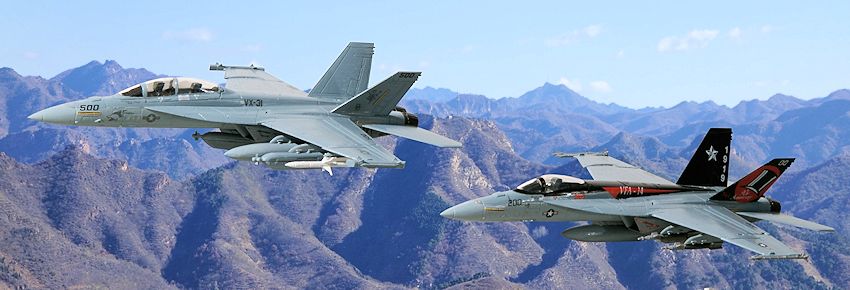
The original Hornet actually grew from the same
design competition the F-16 emerged from, back in the late 70s when the
US realised the F-15, though awesome, was too pricey to completely
replace all the other planes in the USAF line up. The YF-17 lost that
competition but the resulting F/A-18 was picked up by the Navy, the
Marines, and a few air forces like the RAAF and the Spanish Air Force,
as well as by Canada. Both the RAAF and the Canadian airforce
appreciated the twin engine design because of the long distances over
remote territory they both have to contend with. Time went by and the
once-n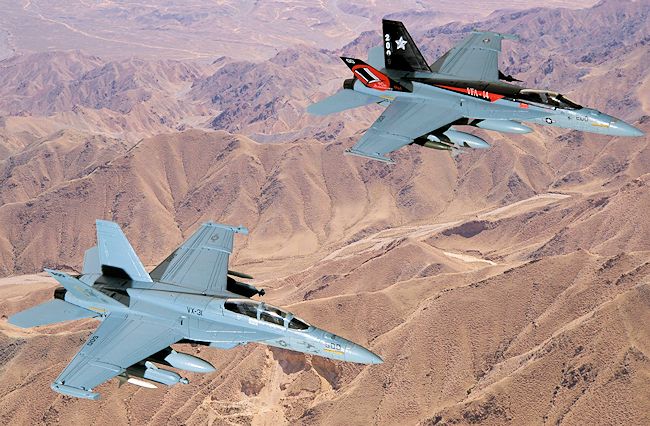 ew Hornet was looking a bit long in the tooth, so the Super Hornet
was designed.
ew Hornet was looking a bit long in the tooth, so the Super Hornet
was designed.
Nominally an F/A-18, and outwardly similar, the Super Hornet is largely
a new design and there is not much parts commonality with the "legacy"
Hornet.
The E model is the standard single seat fighter bomber that replaced the
basic F/A-18C (itself an upgrade from the original A). The E made its
combat debut in November 2002 doing an airstrike while on No Fly Zone
operations over Iraq. They also flew missions during the subsequent US
invasion of that country and the long, drawn out operations that
followed. The G model, called Growler, is a dedicated electronic warfare
variant, pretty new and just coming into service.
The Super Hornet is flown by the US Navy, but not the US Marines, which
still flies the legacy Hornet. Australia bought the Super Hornet for the
RAAF to replace its F-111C fleet, in a politically controversial move
(also amongst modellers and plane fans who preferred the older, but
capable, RAAF F-111C which some thought could have kept going).
Australia also has options on the Growler.
VFA-14 "Tophatters" is the Navy's oldest active squadron. It flew the
F-14 before it switched to the Super Hornet. They flew combat ops during
the US invasion of Iraq. VX-31 "Dust Devils" is a test and evaluation
squadron which put the Growler through its paces.
This is an awesome little double-banger from Dragon, much nicer than
their older 1/144 kits of the legacy Hornet. It's been previewed right
here on MM. It has nicely engraved panel lines, probably out of
scale but they look good. Each
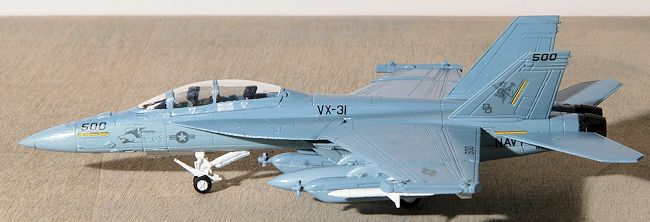 airframe can be built as a single or twin seater, though you only get two canopies so you have to go with one of
each variety.
airframe can be built as a single or twin seater, though you only get two canopies so you have to go with one of
each variety.
The cockpit comes with control panels (no decals) and ejection seats.
You also get a mix of weapons and stores. These include a pair of AGM-88
HARM for the Growler, along with four of the jamming pods the plane
carries, though normally it seems the G would only carry three. These
are nicely done, with little propellors. The wingtip ECM pods have PE
for the tiny little fins on them. You also get a pair of older AIM-9 and
a pair of AIM-9X. There are also four AMRAAMs, four AIM-7, and four
AGM-84 Harpoons. Still hungry? You also get two little targeting pods (I
think they are ATFLIR) and an AGM-84 SLAM-ER plus all the fuel tanks
either plane can carry. Decals are nice, modern and good quality. There
are no bombs.
The kit goes together like any other modern jet. Do the little cockpit,
taking care with the flimsy instrument panels (no decals) and then be
careful to get the slightly complex intake set-up properly aligned. It
looks good when you get it all together. For the G model, you need to
trim the missile rails off the end of the wingtips and replace them with
the larger pods. You can make the wings deployed or folded on both
variants. This leaves a bit of a gap which will need to be dealt with.
end of the wingtips and replace them with
the larger pods. You can make the wings deployed or folded on both
variants. This leaves a bit of a gap which will need to be dealt with.
Being so small, the kit goes together quickly. Tailplanes and tail fins
fit well, as do the underwing pylons. The undercarriage, nicely detailed
for the scale (and with nosewheel options - catapult bar up or down),
also fits positively. On both mine I managed to put the nosegear too far
forward, before realising just before the kits were completed. I ripped
them out and put them in the right spot. You need to cut up the gear bay
doors as they come in one piece, but the real thing has several doors.
There's no real guidance on weapons loadouts but the internet is your
friend here - sort of. It is quite complex actually, and most pictures
seem to be of air to ground loadouts. But the Superbug is also the air
defence fighter for carriers, so it must have a dedicated air to air
loadout style. I couldn't work out what that might be in practice.
Still, you get enough to make something plausible. The kit doesn't have
any laser guided bombs, though, which do seem to feature in the Hornet's
real-world history. It's easier for the Growler of course, because it
just carries the jamming pods and a pair of HARM on the outboard
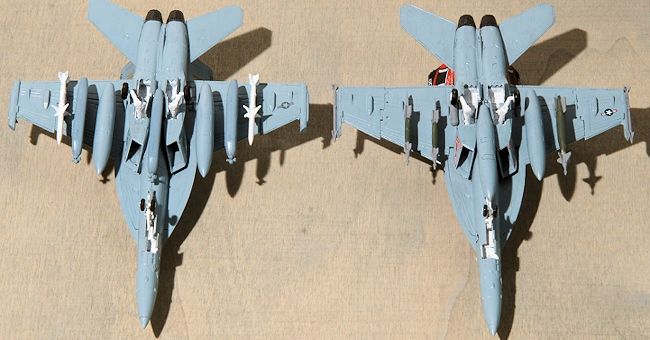 pylons.
It doesn't have Sidewinders because the wingtips have electronics pods
on them. Attaching the little photo etch fins to those pods was a tricky
task but ultimately not as tough as I thought it'd be. They do make it
look a bit cooler, too. You should note that pictures show the little
fins on the top of the pod, front and back, but not at the bottom. You
get plenty of these little fins so don't worry if you lose a few. They
were a bit finicky to apply but look good.
pylons.
It doesn't have Sidewinders because the wingtips have electronics pods
on them. Attaching the little photo etch fins to those pods was a tricky
task but ultimately not as tough as I thought it'd be. They do make it
look a bit cooler, too. You should note that pictures show the little
fins on the top of the pod, front and back, but not at the bottom. You
get plenty of these little fins so don't worry if you lose a few. They
were a bit finicky to apply but look good.
For the E model, I succumbed in the end to an air to ground
configuration. Someone on the MM forum helpfully confirmed that a
colourful CAG bird like this would still do operations, and elsewhere I
discovered that this asymmetric load is apparently pretty normal. The
reason one wing doesn't have a fuel tank is apparently because it blocks
the view of the ATFLIR targeting pod. As noted, this kit doesn't come
with bombs. I took these laser guided bombs from my Dragon Tornado GR.4
kit, so I guess they might be British LGBs. But they're close enough for
me. According to some of the pictures I saw, the AIM-9X would be carried
on one side only, but I put them both on. Asymmetric is one thing, but
silly-looking is another...
The instructions tell you to use Mr Color 307 topsides and 308
underneath, so I did just that. With this kind of colour scheme it is a
bit hard to tell from photos what's the proper shade. On the single
seater, you need to paint the black sections on the tail fins and the
top of the fuselage. I used Tamiya X-18 semi-gloss black here. You need
to work it out carefully, so you can get the red decal to look right.
Look at the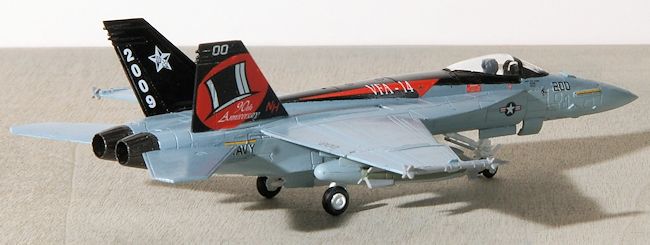 instructions carefully before you barge in. The decals
themselves are nicely printed, go on easily, and respond nicely to a
gentle application of Mr Mark Softer.
instructions carefully before you barge in. The decals
themselves are nicely printed, go on easily, and respond nicely to a
gentle application of Mr Mark Softer.
On the Growler, there's not much to say. The markings are pretty
austere.
On the E model, I made a bit of a mistake. The NH on the bottom front
corner of the tail is on the wrong side - it should be swept not leaning
forward. By the way, according to wikipedia, the squadron's tail code is
NG. Also, you need to take care with that red stripe on the top of the
fuselage. Getting the paint in the right alignment with the decal takes
a bit of planning.
Both planes have yellow stripes for the so-called slime lights, the low
voltage lights that help pilots formate off each other in darkness.
These go on engraved lines on the kit, and that's fine except for in
front of the elevons or tailerons, whatever we're calling tailplanes
these days. I'm not convinced the kit's lines are in the right spot, so
I just went with what looked right to me.
Great kit! Thoroughly recommended.
http://en.wikipedia.org/wiki/F/A-18E/F_Super_Hornet
Richard F
December 2014If you would like your product reviewed fairly and fairly quickly, please
contact
the editor or see other details in the
Note to
Contributors.
Back to the Main Page
Back to the Review
Index Page


 ew Hornet was looking a bit long in the tooth, so the Super Hornet
was designed.
ew Hornet was looking a bit long in the tooth, so the Super Hornet
was designed. airframe can be built as a single or twin seater, though you only get two canopies so you have to go with one of
each variety.
airframe can be built as a single or twin seater, though you only get two canopies so you have to go with one of
each variety. end of the wingtips and replace them with
the larger pods. You can make the wings deployed or folded on both
variants. This leaves a bit of a gap which will need to be dealt with.
end of the wingtips and replace them with
the larger pods. You can make the wings deployed or folded on both
variants. This leaves a bit of a gap which will need to be dealt with. pylons.
It doesn't have Sidewinders because the wingtips have electronics pods
on them. Attaching the little photo etch fins to those pods was a tricky
task but ultimately not as tough as I thought it'd be. They do make it
look a bit cooler, too. You should note that pictures show the little
fins on the top of the pod, front and back, but not at the bottom. You
get plenty of these little fins so don't worry if you lose a few. They
were a bit finicky to apply but look good.
pylons.
It doesn't have Sidewinders because the wingtips have electronics pods
on them. Attaching the little photo etch fins to those pods was a tricky
task but ultimately not as tough as I thought it'd be. They do make it
look a bit cooler, too. You should note that pictures show the little
fins on the top of the pod, front and back, but not at the bottom. You
get plenty of these little fins so don't worry if you lose a few. They
were a bit finicky to apply but look good. instructions carefully before you barge in. The decals
themselves are nicely printed, go on easily, and respond nicely to a
gentle application of Mr Mark Softer.
instructions carefully before you barge in. The decals
themselves are nicely printed, go on easily, and respond nicely to a
gentle application of Mr Mark Softer.